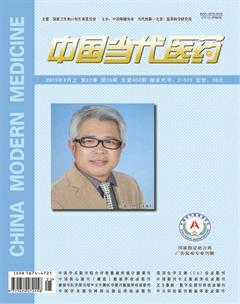帕洛诺司琼联合地塞米松预防术后恶心呕吐的Meta分析
孔翔 高淑红 林红梅



[摘要] 目的 系统评价帕洛诺司琼联合地塞米松预防术后恶心呕吐(PONV)的疗效,为合理制定PONV的预防方案提供高质量证据。 方法 计算机检索PubMed、The Cochrane Library、中国生物医学文献数据库、中国知网、万方数据库、维普数据库,检索时限均为建库至2014年11月,收集帕洛诺司琼联合地塞米松预防PONV的随机对照试验。由2位评价者按纳入和排除标准独立筛选文献、提取资料和质量评价后,采用Rev Man 5.2软件进行Meta分析。 结果 纳入6项随机对照试验,共466例患者。Meta分析结果显示,帕洛诺司琼可有效降低PONV的发病率;帕洛诺司琼联合地塞米松较单用帕洛诺司琼更能降低术后恶心的发病率,亦能有效降低呕吐的发病率;联合用药较单一用药不能降低接受长时程手术的女性患者PONV的发病率。 结论 帕洛诺司琼联合地塞米松可降低PONV的发生率,但对合并多种危险因素者,联合用药较单一用药无优势,受纳入研究质量和数量限制,上述结论需更多高质量的随机对照试验加以验证。
[关键词] 帕洛诺司琼;地塞米松;术后恶心呕吐;Meta分析;随机对照试验
[中图分类号] R442.1 [文献标识码] A [文章编号] 1674-4721(2015)09(a)-0004-05
[Abstract] Objective To evaluate the efficacy of palonosetron with dexamethasone for prevention of postoperative nausea and vomiting(PONV),so as to provide high quality evidence for formulating the rational prevention of PONV. Methods The randomized controlled trails(RCTs) on palonosetron with dexamethasone for prevention were searched in PubMed,the Cochrane Library,CBM,CNKI,WanFang Data and VIP from the date of their establishment to November 2014.According to the inclusion and exclusion criteria,two reviewers independently screened the studies,extracted the data and assessed the quality.Then Rev Man 5.2 software was used for Meta-analysis. Results A total of 6 RCTs involving 466 patients were included.The results of Meta-analysis suggested that,palonosetron alone could decrease the incidence of PONV,palonosetron with dexamethasone could decrease both the incidence of nausea and vomiting.However,for female patient who accepted long time operation,the combination therapy of palonosetron with dexamethasone did not reduce the incidence of nausea and vomiting when compared with palonosetron alone. Conclusion Based on the current studies,palonosetron with dexamethasone can decrease the incidence of PONV,but combination therapy compared with monotherapy no advantage for patients with high risk factors.Due to the limited quality and quantity of the included studies,more high quality RCTs are required to further verify this conclusion.
[Key words] Palonosetron;Dexamethasone;Postoperative nausea and vomiting;Meta-analysis;Randomized controlled trial
自19世纪40年代全身麻醉得以运用时,人们就注意到患者术后常出现恶心、呕吐症状。据统计,全身麻醉患者术后恶心呕吐(postoperative nausea and vomiting,PONV)发病率约为30%,而在高风险人群中其比例可高达80%[1]。PONV不仅增加了患者不良心理体验,而且也可导致电解质紊乱、切口或吻合口撕裂、误吸等严重并发症,在影响治疗效果的同时也增加了医疗费用。帕洛诺司琼是治疗PONV的新一代药物,新近研究发现,其与地塞米松联用可增强疗效[2-4],但也有持相反观点的研究[5-7]。本文旨在运用Meta分析方法综合评价帕洛诺司琼与地塞米松联用预防PONV的疗效,为临床实践提供循证医学证据。
1 资料与方法
1.1 纳入标准与排除标准
1.1.1 纳入标准 ①随机对照试验,无论采用盲法与否;②研究对象:美国麻醉医师协会分级Ⅰ~Ⅱ接受全身麻醉并行手术治疗的患者,年龄>18周岁,性别、种族不限;③干预措施:试验组静脉注射帕洛诺司琼及地塞米松,对照组仅予以帕洛诺司琼;④观察指标:术后24 h内恶心、呕吐症状发生与否。
1.1.2 排除标准 ①术后应用镇痛泵;②联合其他药物进行预防;③组间帕洛诺司琼用量不一致;④无法直接或间接获得数据;⑤重复发表的研究。
1.2 文献检索策略
计算机检索PubMed、The Cochrane Library、中国生物医学文献数据库、中国知网、万方数据库、维普数据库,检索年限均为建库至2014年11月。中文检索词为:帕洛诺司琼、地塞米松、术后恶心呕吐;英文检索词为:palonosetron、dexamethasone、postoperative nausea and vomiting。
1.3 文献筛选及质量评价
由2名评价员按照预先设计的表格独立进行资料提取,并交叉核对,如遇分歧,在第3位研究员组织讨论后定夺。对纳入研究的文献依据Cochrane系统评价员手册5.2版本进行质量评价,着重评价随机分配方法、是否分配隐藏、是否采用盲法、是否选择性报告研究结果及有无其他偏倚因素。
1.4 统计学方法
采用Rev Man 5.2统计学软件对异质性和疗效效应量进行分析,计数资料采用相对危险度(RR),计量资料采用加权均数差(WMD)或标准均数差(SMD),效应量以95%CI表示。各纳入研究结果的异质性采用χ2检验评估,若各研究结果间有统计学同质性(P>0.1,I2<50%),选择固定效应模型进行Meta分析;若各研究结果间存在统计学异质性(P<0.1,I2>50%),则分析异质性产生的来源,对可能导致异质性的因素进行亚组分析;若仅有统计学异质性而无临床异质性时,采用随机效应模型进行Meta分析;若异质性过大时,则行描述性分析。
2 结果
2.1 文献检索结果
初检索出相关文献30篇,不同数据库重复文献11篇,阅读摘要后排除不符合纳入标准的文献7篇,因无法提取数据排除文献1篇[8]。最终纳入6项随机对照试验,其中3项来自中国[2,4-5],其余分别来自韩国[6]、印度[3]和美国[7],共包括466名患者(表1)。
2.2 纳入研究的特点及其质量评价
所有纳入的研究均提及随机,但仅有2项研究[3,5]交代随机方法且方法正确,2项研究[3,6]采用双盲方法并提及隐蔽分组,但未具体描述,所有研究均无失访。仅1项研究[5]报告不良反应(图2)。
2.3 Meta分析结果
2.3.1 单一用药对PONV的影响 2项研究[2,5]比较了单用帕洛诺司琼及安慰剂对PONV的预防作用,两者研究结果存在异质性(P=0.13,I2=57%),由于研究数量不满足亚组分析条件,故采用随机效应模型进行Meta分析,结果显示,帕洛诺司琼可有效降低PONV发病率[RR=1.96,95%CI(1.12,3.43),P=0.02]。
2.3.2 联合用药与单一用药预防PONV的比较 纳入的所有研究均比较了帕洛诺司琼联合地塞米松与单用帕洛诺司琼预防POVN的作用,但各研究结果间存在异质性(P=0.05,I2=55%),故进一步行亚组分析,结果显示,帕洛诺司琼联合地塞米松较单用帕洛诺司琼更能降低术后恶心发病率[RR=1.55,95%CI(1.09, 2.20),P=0.01],亦能有效降低呕吐发病率[RR=2.48, 95%CI(1.13,5.46),P=0.02](图1)。
2.3.3 联合用药与单一用药预防女性患者长时程手术PONV的比较 3项研究[4-6]比较了两种干预方法对女性患者长时程手术术后PONV的发病率,各研究间同质性较高(P=0.36,I2=3%)。采用固定效应模型分析显示,对于此类患者,帕洛诺司琼联合地塞米松的治疗效率与单用帕洛诺司琼治疗效率差异无统计学意义[RR=1.05,95%CI(0.67,1.65),P=0.82](图2)。
2.3.4 发表偏倚 漏斗图分析提示本研究可能受发表偏倚影响,尤其在评价两种干预方式对呕吐的作用时发表偏倚更为突出(图3)。
3 讨论
PONV病理生理机制复杂,感受器通过多巴胺、乙酰胆碱、阿片类物质、组胺等神经递质将信号传至中枢,根据神经递质及其作用受体,现已制备出丁酰苯类(氟哌利多)、酚噻嗪类(氯丙嗪)、苯甲酰胺类(甲氧氯普胺)、抗组胺类(茶苯海明)、抗胆碱能类(阿托品)及5-羟色胺受体拮抗剂(昂丹司琼)等多种抗PONV药[9]。由于孤束核是呕吐信号传递的共同通路,且其中富集大量5-羟色胺受体,故5-羟色胺受体拮抗剂抗PONV的效果较好。帕洛诺司琼是第2代5-羟色胺受体拮抗剂,其突破了此类药物以吲哚为母核的传统,以苯并异喹啉环为母核,增强了分子刚性,从而提高了其对5-羟色胺3受体的亲和力及特异性结合力;且该药物可通过调节Ca2+/CaMKⅡ依赖的ERK1/2通路防治PONV[10-11]。因此,帕洛诺司琼较同类药物不仅靶向性更强、疗效更佳,且副作用更少。近来研究证实,帕洛诺司琼能减轻化疗药物引起的恶心呕吐症状[12-15],有学者也比较了该药物预防心血管手术与非心血管手术POVN的作用[16],从不同麻醉方式进行了比较[17],研究结果均肯定了帕洛诺司琼的作用,现FDA已批准该药物用于化疗引起的恶心呕吐[18]。
帕洛诺司琼用于防治PONV是一新的方向,本研究Meta分析了6项随机对照研究,结果证实,单用帕洛诺司琼能有效降低PONV的发病率,一定条件下联用地塞米松可进一步增强其疗效。但对接受长时程手术的女性患者PONV发生情况进行亚组分析时发现,帕洛诺司琼联合地塞米松与单用帕洛诺司琼比较疗效差异无统计学意义。继往研究表明,吸入麻醉气体>2 h可增加PONV危险性[19],女性亦是PONV的明确危险因素[20],当多种危险因素叠加时大大增加了干预难度,此时联用地塞米松优势消失,可能源于PONV是多因素作用的结果所致。虽然5-羟色胺及其受体在PONV病理生理机制中发挥重要作用,但在合并多种危险因素时,其他潜在危险的路径可能被激活,恶心呕吐信号通过非5-羟色胺途径传递,由此提示,对于存在多种危险因素的患者,需通过更加复杂的多模式处理才能取得理想疗效。尽管5-羟色胺受体拮抗剂联合地塞米松的方案已写入部分指南[20],但此方案的药理学机制研究鲜见,两者之间的药物相互作用机制亦知之甚少,指南提及此方案概基于临床研究,但目前临床研究存在试验设计方案不合理、干预方式不统一、研究规模局限等诸多问题,其证据级别不高。
通过Meta分析可深入了解现阶段研究情况,发掘存在的问题,为临床实践提供科学的阶段性建议。本研究提示,预防性静脉注射帕洛诺司琼能有效降低PONV的发病率,地塞米松与其联用可发挥协同作用,对具有多种危险因素的患者需要联合更多干预方法才能取得较好疗效。
综上所述,帕洛司琼联合地塞米松预防PONV有一定优势,但受目前研究质量限制,加之病理生理学机制及药理学机制尚未明确,故不推荐将帕洛诺司琼联合地塞米松作为预防PONV的常规方案运用。
[参考文献]
[1] Skolnik A,Gan TJ.Update on the management of postoperative nausea and vomiting[J].Curr Opin Anaesthesiol,2014,27(6):605-609.
[2] 刘家锋,赖华英,彭韶平,等.帕洛诺司琼联合地塞米松预防甲状腺切除术后恶心、呕吐[J].中国医药指南,2014, 12(26):222-223.
[3] Bala I,Bharti N,Murugesan S,et al.Comparison of palon-osetron with palonosetron-dexamethasone combination for prevention of postoperative nausea and vomiting in patients undergoing laparoscopic cholecystectomy[J].Minerva Anestesiol,2014,80(7):779-784.
[4] 黄贤君,林世清,陈祯,等.帕洛诺司琼联合地塞米松预防术后恶心呕吐的临床观察[J].现代医院,2011,11(11):20-22.
[5] 刘文兴,宋兴荣,劳建新.帕洛诺司琼联合地塞米松对舒芬太尼妇科腹腔镜术后镇痛期间恶心呕吐的影响[J].广东医学,2012,33(23):3645-3647.
[6] Park JW,Jun JW,Lim YH,et al.The comparative study to evaluate the effect of palonosetron monotherapy versus palonosetron with dexamethasone combination therapy for prevention of postoperative nausea and vomiting[J].Korean J Anesthesiol,2012,63(4):334-339.
[7] Blitz JD,Haile M,Kline R,et al.A randomized double blind study to evaluate efficacy of palonosetron with dexamethasone versus palonosetron alone for prevention of postoperative and postdischarge nausea and vomiting in subjects undergoing laparoscopic surgeries with high emetogenic risk[J].Am J Ther,2012,19(5):324-329.
[8] S D,Jd V,M H,et al.A randomized,double blind study to evaluate the efficacy of palono-setron with dexamethasone versus palonosetron alone for prevention of post-operative nausea and vomiting in subjects undergoing bariatric surgeries with high emetogenic risk[J].Open Anesthesiol J,2013,(7):30-36.
[9] Horn CC,Wallisch WJ,Homanics GE,et al.Pathophysiological and neurochemical mechanisms of postoperative nausea and vomiting[J].Eur J Pharmacol,2014,(722):55-66.
[10] Zhong W,Hutchinson TE,Chebolu S,et al.Serotonin 5-HT3 receptor-mediated vomiting occurs via the activation of Ca2+/CaMKⅡ-dependent ERK1/2 signaling in the least shrew(Cryptotis parva)[J].PLoS One,2014,9(8):e104718.
[11] Darmani NA,Zhong W,Chebolu S,et al.Differential and additive suppressive effects of 5-HT3(palonosetron)-and NK1(netupitant)-receptor antagonists on cisplatin-induced vomiting and ERK1/2,PKA and PKC activation[J].Pharmacol Biochem Behav,2015,(131):104-111.
[12] Takatori E,Shoji T,Miura Y,et al.A phase Ⅱ clinical trial of palonosetron for the management of delayed vomiting in gynecological cancer patients receiving paclitaxel/carboplatin therapy[J].Mol Clin Oncol,2015,3(2):281-286.
[13] Morrow GR,Schwartzberg L,Barbour SY,et al.Palonosetron versus older 5-HT3 receptor antagonists for nausea prevention in patients receiving chemotherapy:a multistudy analysis[J].J Community Support Oncol,2014,12(7):250-258.
[14] Tricco AC,Soobiah C,Hui W,et al.Interventions to decrease the risk of adverse cardiac events for patients receiving chemotherapy and serotonin(5-HT3) receptor antagonists:a systematic review[J].BMC Pharmacol Toxicol,2015,16(1):1.
[15] Saito M,Aogi K,Sekine I,et al.Palonosetron plus dexamethasone versus granisetron plus dexamethasone for prevention of nausea and vomiting during chemotherapy:a double-blind,double-dummy,randomised,comparative phase Ⅲ trial[J].Lancet Oncol,2009,10(2):115-124.
[16] Min JJ,Kim HJ,Jung SY,et al.Effects of palonosetron on perioperative cardiovascular complications in patients undergoing noncardiac surgery with general anesthesia:a retrospective cohort study[J].Clin Pharmacol Ther,2015, 98(1):96-106.
[17] Chattopadhyay S,Goswami S.Palonosetron versus ramos-etron prophylaxis for control of postoperative nausea and vomiting after cesarean delivery under spinal anesthesia[J].J Obstet Gynaecol India,2015,65(1):28-33.
[18] Thompson CA.Netupitant-palonosetron combination approved by FDA[J].Am J Health Syst Pharm,2014,71(23):2000.
[19] Apfel CC,Kranke P,Katz MH,et al.Volatile anaesthetics may be the main cause of early but not delayed postoperative vomiting:a randomized controlled trial of factorial design[J].Br J Anaesth,2002,88(5):659-668.
[20] Gan TJ,Diemunsch P,Habib AS,et al.Consensus guidelines for the management of postoperative nausea and vomiting[J].Anesth Analg,2014,118(1):85-113.
(收稿日期:2015-03-24 本文编辑:王红双)

